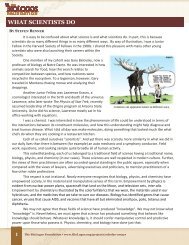Miracles and Science: The Long Shadow of David Hume - BioLogos
Miracles and Science: The Long Shadow of David Hume - BioLogos
Miracles and Science: The Long Shadow of David Hume - BioLogos
Create successful ePaper yourself
Turn your PDF publications into a flip-book with our unique Google optimized e-Paper software.
<strong>The</strong> <strong>BioLogos</strong> Foundation • www.<strong>BioLogos</strong>.org/projects/scholar-essays<br />
claim on reality than any other form <strong>of</strong> knowledge. But scientists as a whole have reacted to this<br />
proposition in a negative way. 7 Although they agree that all kinds <strong>of</strong> economic, historical <strong>and</strong> social factors<br />
do play a role in the formation <strong>of</strong> scientific theories, they would argue that, in the long run, the scientific<br />
process does lead to reliable knowledge about the world.<br />
<strong>The</strong> view <strong>of</strong> nature embraced by most scientists that I know could be described as critical realism. <strong>The</strong>y are<br />
realists because they believe that there is a world out there that is independent <strong>of</strong> our making. <strong>The</strong><br />
adjective “critical” is added because they recognize that extracting knowledge about that world is not<br />
always straightforward. Thus, the primary role <strong>of</strong> the collective nature <strong>of</strong> the scientific process is to provide<br />
a network <strong>of</strong> error-correcting mechanisms that prevent us from fooling ourselves. <strong>The</strong> continual testing<br />
against nature refines <strong>and</strong> filters out competing scientific theories, leading to advances in the strength <strong>and</strong><br />
reliability <strong>of</strong> our scientific knowledge tapestries.<br />
Although there are many commonalities in the ways that scientists in distinct fields assemble their tapestry<br />
arguments, there can also be subtle differences. <strong>The</strong>se differences are foisted on us in part by the types <strong>of</strong><br />
problems that each field attempts to address. For example, as a theoretical physicist I’ve been trained in a<br />
tradition <strong>of</strong> what the Nobel Laureate Eugene Wigner called “the unreasonable effectiveness <strong>of</strong><br />
mathematics:”<br />
<strong>The</strong> miracle <strong>of</strong> the appropriateness <strong>of</strong> the language <strong>of</strong> mathematics for the formulation <strong>of</strong> the laws<br />
<strong>of</strong> physics is a wonderful gift which we neither underst<strong>and</strong> nor deserve. We should be grateful for it<br />
<strong>and</strong> hope that it will remain valid in future research <strong>and</strong> that it will extend, for better or for worse, to<br />
our pleasure, even though perhaps also to our bafflement, to wide branches <strong>of</strong> learning. 8<br />
We believe, based on a history <strong>of</strong> spectacular success, that mathematical consistency among threads is a<br />
key indicator <strong>of</strong> strong tapestries. 9 <strong>The</strong>se days, I spend much <strong>of</strong> my time interacting with biologists who<br />
tend to view my confidence in the ability <strong>of</strong> theoretical models to extract knowledge about the physical<br />
world with great suspicion. 10 I, on the other h<strong>and</strong>, am <strong>of</strong>ten instinctively sceptical <strong>of</strong> the huge error bars<br />
that can afflict their data. 11<br />
To a large degree, these cultural differences are forced on us by the kinds <strong>of</strong> questions we study. My<br />
reaction above arises because physics is self-limiting. As a community we simply don’t deal with problems<br />
<strong>of</strong> the same level <strong>of</strong> complexity that biology does. If an experiment is too messy we will <strong>of</strong>ten define it<br />
away by declaring “that isn’t physics,” <strong>and</strong> move on. Similarly, molecular biologists can afford to be more<br />
selective about their data than medical scientists or psychologists can. 12<br />
But, despite these cultural differences, which can lead to heated <strong>and</strong> sometimes frustrating discussion, we<br />
do agree on a number <strong>of</strong> ground rules for defining what makes a tapestry strong. For example, what we<br />
either predict or measure should be repeatable. If I claim to see an effect in an experiment, someone else<br />
in a different lab should be able to reliably measure the same effect. 13 That simple requirement has many<br />
ramifications for the types <strong>of</strong> problems we are able to address<br />
3<br />
<strong>Miracles</strong> <strong>and</strong> <strong>Science</strong>:<br />
<strong>The</strong> <strong>Long</strong> <strong>Shadow</strong> <strong>of</strong> <strong>David</strong> <strong>Hume</strong><br />
BY ARD LOUIS




